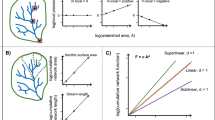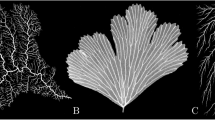Abstract
The search for a theory to explain why the metabolic rate of mammals is proportional to the 3/4-power of body mass (Kleiber's law) has recently focused on the nutrient distribution network formed by arteries and capillaries. Banavar et al.1 argue that the law follows from the intrinsic properties of an outward-directed network. But careful analysis of their arguments reveals two implicit assumptions that may not be generally correct. Unless these assumptions are valid for mammalian circulation, these arguments cannot satisfactorily explain Kleiber's empirical relationship.
Similar content being viewed by others
Main
In the analysis by Banavar et al.1, there is a site for nutrient uptake at each network-branching point, and the distance LX along a path from the origin O (the heart) to a site X is defined as the number of uptake sites on the path. The rate of uptake of nutrients at a site is a constant FX (assumed to be species- and size-invariant). A network segment that goes from a site X to an adjacent site Y is termed the link XY, and the rate at which nutrient enters the link is termed the current and is denoted by IXY. In an outward-directed network (ODN), the direction of flow is away from O on each link.
The authors' fundamental result is that, in an ODN, C=B< LX>, where C, the total current in the network, is the sum of currents on all links, B is the metabolic rate (sum of uptake rates), and <LX> is the average distance to sites. The number of uptake sites is expressed as L3, and the metabolic rate B is therefore FXL3. Banavar et al. prove that, if <LX> is proportional to L, if C is proportional to blood volume Vb, and if Vb is proportional to body size M, then B is proportional to M3/4, which is Kleiber's law.
Although the assumption that Vb∝M is a reasonable approximation, the assumption that C∝Vb is not, in general, true. Consider a network formed by (l−1)(m−1)( n−1) unit cubes stacked to form a rectangle (l−1) units deep by (m−1) units wide by (n−1) units high. Each vertex of a cube is an uptake site and each edge is a network link with constant cross-sectional area. Current is supplied to the bottom rear left corner of the network and flows forward, rightward and upward. It follows from induction on n that the sum of currents in all vertical links is lmn( n+1)FX/2. Adding the corresponding expressions for currents flowing rightward and forward gives lmnFX(l+m +n+3)/2, the total current C. The blood in the network is proportional to the number of links, 3lmn−lm− ln−mn. Thus, in this model, in which the density of uptake sites is invariant, C is nearly proportional to volume multiplied by average linear dimension, metabolism is proportional to volume, and Vb is approximately proportional to volume.
The relation between Vb and C depends on parameters that do not appear in Banavar et al.'s report1. The volume of blood in link XY is equal to the cross-sectional area of the link (AXY) multiplied by the length of the link (sXY), whereas current IXY is AXY multiplied by flow velocity (fXY). The volume of blood in a link is therefore IXYsXY /fXY. The assumption that the sum of currents equals (or scales as) total blood volume implies that the average value of sXY increases as size increases. In arteries, the flow velocity may increase as size increases, but flow rates in capillaries are severely constrained by their relatively constant cross-sectional area and pressure. If most uptake sites are located in capillary networks, the currents in capillaries comprise most of the sum C, but the blood in these vessels may comprise a minority of blood volume.
The assumption that <LX>∝L is also not true in general in an ODN. For example, consider a network that starts with a single link and bifurcates at each branch point until a terminal uptake site is reached at distance k. The number of uptake sites, L3, is 2k−1 and <LX> is [(k−1)2k−1]/(2k−1). Therefore <LX> is approximately proportional to the logarithm of L in this type of ODN.
References
Banavar, J. R., Maritan, A. & Rinaldo, A. Nature 399, 130– 132 (1999).
Schmidt-Nielsen, K. Scaling: Why is Animal Size so Important? (Cambridge Univ. Press, 1984).
West, G. B., Brown, J. H. & Enquist, B. J. Science 284, 1677– 1679 (1999).
Ritter, D. F., Kochel, C. R. & Miller, J. R. Process Geomorphology 3rd edn (WCB/McGraw-Hill, Boston, 1995).
Rodriguez-Iturbe, I. & Rinaldo, A. Fractal River Basins: Chance and Self-Organization (Cambridge Univ. Press, New York, 1997).
Banavar, J. R. et al. Phys. Rev. Lett. 78, 4522– 4525 (1997).
Author information
Authors and Affiliations
Corresponding author
Rights and permissions
About this article
Cite this article
Painter, P. Rivers, blood and transportation networks. Nature 408, 159 (2000). https://doi.org/10.1038/35041631
Issue Date:
DOI: https://doi.org/10.1038/35041631
This article is cited by
-
Data from necropsy studies and in vitro tissue studies lead to a model for allometric scaling of basal metabolic rate
Theoretical Biology and Medical Modelling (2005)
-
Supply-demand balance in outward-directed networks and Kleiber's law
Theoretical Biology and Medical Modelling (2005)
-
Biological scaling and physics
Journal of Biosciences (2002)
Comments
By submitting a comment you agree to abide by our Terms and Community Guidelines. If you find something abusive or that does not comply with our terms or guidelines please flag it as inappropriate.



